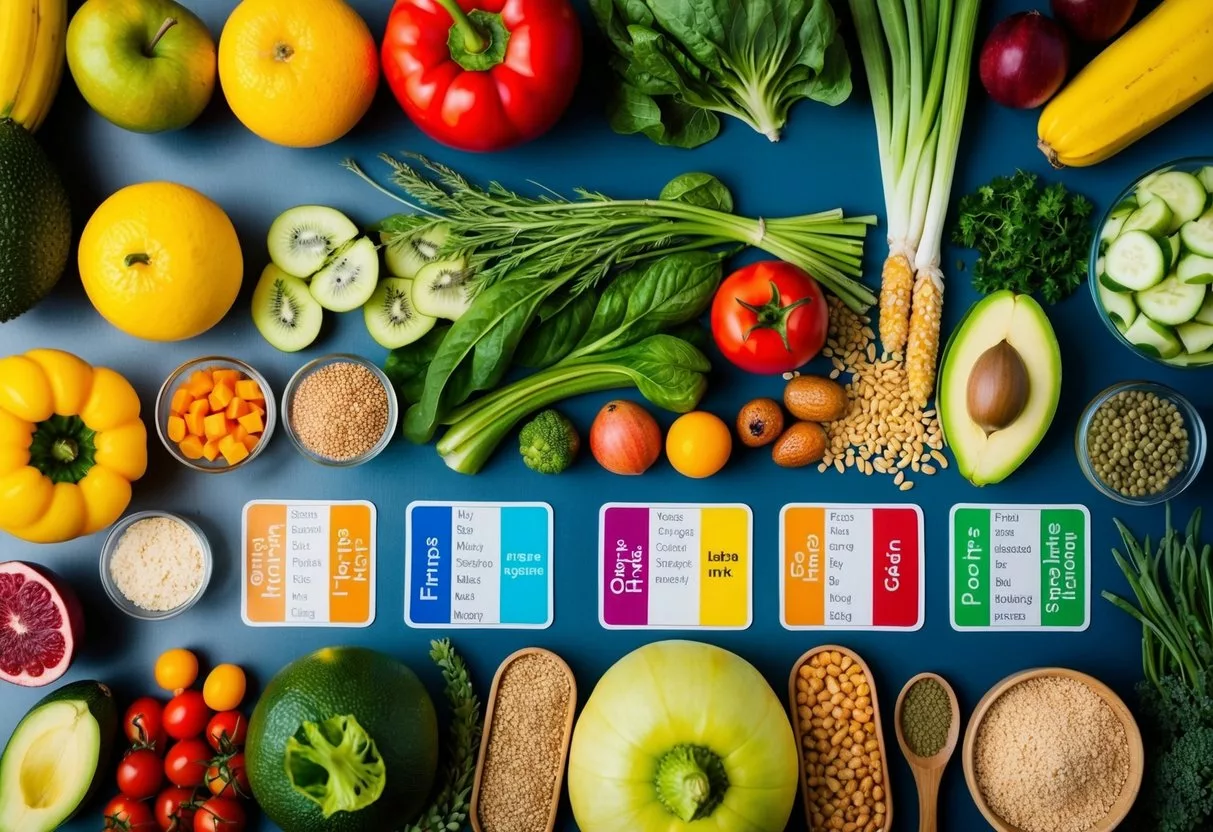Culinary medicine is a fresh approach to health that blends the art of cooking with the science of medicine. This field aims to help people make better food choices to prevent and treat diseases. Culinary medicine teaches how to prepare tasty, nutritious meals that support well-being[1].

Doctors and patients alike can benefit from learning culinary medicine skills. The practice focuses on using food as a tool for healing and maintaining good health. It takes into account personal tastes, cultural preferences, and individual health needs.
Culinary medicine programs[2] offer courses for healthcare professionals to integrate food knowledge into their clinical practice. These programs include online learning, live events, and hands-on cooking classes. By mastering these skills, healthcare providers can better guide their patients toward healthier eating habits.
The Principles of Culinary Medicine

Culinary medicine combines food science with medical knowledge to promote health. It focuses on using whole foods and cooking techniques to prevent and treat diseases.
Food as a Factor in Disease Prevention
Culinary medicine[3] emphasizes the role of food in preventing illnesses. It teaches people to choose and prepare meals that boost their health. The field promotes eating whole, minimally processed foods rich in nutrients.
Fruits, vegetables, and whole grains are key components. These foods contain phytonutrients that help fight diseases. Culinary medicine also encourages reducing added sugars, unhealthy fats, and excess sodium.
Cooking methods matter too. Steaming, roasting, and grilling preserve nutrients better than deep-frying. The goal is to make healthy food tasty and appealing.
Nutrient Intake Optimization
Culinary medicine aims to maximize nutrient intake through smart food choices and preparation. It teaches how to combine foods for better nutrient absorption. For example, pairing iron-rich foods with vitamin C improves iron uptake.
Portion control is another important aspect. It helps people get the right amount of nutrients without overeating. Culinary medicine programs[4] often include hands-on cooking classes. These classes teach skills to create balanced, nutritious meals.
The field also addresses special dietary needs. It provides strategies for those with food allergies or chronic diseases like diabetes. By optimizing nutrient intake, culinary medicine supports overall health and wellbeing.
Role of Diet in Chronic Diseases

Diet plays a crucial role in preventing and managing chronic diseases. What we eat impacts our health in many ways, affecting weight, blood sugar, heart function, and more.
Obesity and Type 2 Diabetes
Poor diet is a major factor in obesity and type 2 diabetes. Eating too many calories, especially from sugary and processed foods, leads to weight gain. Extra body fat makes it harder for insulin to work properly.
Culinary medicine[5] teaches people how to prepare healthy meals at home. This helps with weight control and blood sugar management. Simple steps like:
• Choosing whole grains over refined carbs
• Eating more vegetables and fruits
• Limiting sugary drinks and snacks
These changes can make a big difference. Even small weight loss improves insulin sensitivity in people with diabetes.
Cardiovascular Disease
Heart disease is closely tied to diet. Eating habits affect key risk factors like blood pressure, cholesterol, and inflammation.
A heart-healthy diet includes:
• Lean proteins (fish, beans, skinless poultry)
• Plenty of fruits and vegetables
• Whole grains
• Healthy fats from nuts, seeds, and olive oil
Food as medicine[6] approaches use specific foods to lower heart disease risk. For example, oats can help reduce “bad” LDL cholesterol. Fatty fish provides omega-3s that fight inflammation.
Limiting salt, saturated fat, and trans fats is also key for heart health. Learning to cook tasty meals without these ingredients is an important skill.
Management of Internal Medicine Conditions
Diet affects many other chronic health issues beyond heart disease and diabetes. Proper nutrition can help manage conditions like:
• High blood pressure
• Kidney disease
• Digestive disorders
• Autoimmune diseases
For example, people with kidney disease often need to limit certain minerals. Those with celiac disease must avoid gluten. The right diet can ease symptoms and slow disease progression in many cases.
Culinary medicine programs[7] teach doctors and patients about food’s role in health. This helps create personalized eating plans for different medical needs. Learning cooking skills makes it easier to follow these plans long-term.
Nutrition and Lifestyle Medicine

Proper nutrition and lifestyle choices play a key role in preventing and managing chronic diseases. Certain dietary patterns and food groups have been shown to have significant health benefits.
Whole Grains and Legumes in Diet
Whole grains and legumes are important parts of a healthy diet. Whole grains contain all parts of the grain kernel and provide fiber, vitamins, and minerals. Examples include brown rice, oats, and whole wheat bread.
Legumes like beans, lentils, and peas are high in protein and fiber. They can help control blood sugar and lower cholesterol. Both whole grains and legumes may reduce the risk of heart disease, diabetes, and certain cancers.
Experts recommend eating 3 servings of whole grains daily. For legumes, aim for 3 cups per week. These foods can easily be added to meals like salads, soups, and stir-fries.
The Mediterranean Diet and Other Healthy Eating Patterns
The Mediterranean diet[8] is a well-studied eating pattern linked to many health benefits. It focuses on:
- Fruits and vegetables
- Whole grains
- Olive oil
- Fish and poultry
- Limited red meat
This diet may lower the risk of heart disease, stroke, and diabetes. It can also help with weight management.
Other healthy eating patterns include the DASH diet and plant-based diets. These share common themes like eating more plants and less processed foods. Lifestyle medicine[8] uses these dietary approaches along with other healthy habits to prevent and treat chronic diseases.
Medical Education in Culinary Medicine

Culinary medicine is becoming an important part of medical education. It teaches future doctors how to use food and nutrition to prevent and treat diseases. This approach combines cooking skills with medical knowledge.
Culinary Medicine Continuing Medical Education
Continuing medical education in culinary medicine[9] is available for health professionals. Doctors, nurses, and other medical staff can take classes to learn about food as medicine. These courses often include hands-on cooking sessions.
Classes are offered regularly, usually at least twice a month. They cost around $150 per class for health professionals. Topics covered may include:
- Basic cooking techniques
- Using spices for flavor and health
- Plant-based proteins
- Whole grains and their benefits
Health professionals can earn continuing education credits by taking these classes. This helps them stay up-to-date on the latest in nutrition and medicine.
Teaching Kitchen Concept
The teaching kitchen is a key part of culinary medicine education. It’s a place where medical students and professionals learn to cook healthy meals. This hands-on approach helps them understand food better.
In teaching kitchens, students:
- Learn basic cooking skills
- Prepare nutritious recipes
- Discuss how food affects health
Many medical schools now use teaching kitchens[10] as part of their curriculum. This practical experience helps future doctors give better nutrition advice to patients.
Teaching kitchens also show how to make healthy food taste good. This is important for helping patients stick to dietary changes.
Impacts of Fast Food and Processed Foods

Fast food and processed foods can harm health in many ways. They often contain too much salt, sugar, and unhealthy fats. These foods may lead to weight gain and raise blood pressure.
Understanding Nutritional Labels
Reading food labels helps people make better choices. Labels show calories, fat, sugar, and salt in foods. Many fast foods have high amounts of these. For example, a single fast food meal can have over 1,000 calories. This is half of what most adults need in a day.
Labels also list ingredients. Processed foods often have long lists with hard-to-say words. These are often chemicals added to make food last longer or taste better. Fresh, whole foods usually have shorter, simpler ingredient lists.
Some fast food places now show calorie counts on menus. This can help people pick lower-calorie options.
High Blood Pressure and Sugar Content
Fast food is often high in sodium[11]. Too much sodium can raise blood pressure. High blood pressure raises the risk of heart attack and stroke.
Many fast foods also have lots of added sugar. Sugary drinks like soda are a big source. A large soda can have over 60 grams of sugar. That’s more than the daily limit for most adults.
Too much sugar can lead to weight gain. It may also increase the risk of type 2 diabetes. Choosing water or unsweetened drinks instead of soda can help cut sugar intake.
Eating less fast food and more home-cooked meals can help lower blood pressure and sugar intake. This may lead to better health over time.
The Science of Cooking for Health

Cooking methods and skills play a crucial role in creating nutritious meals. The right techniques can preserve nutrients and enhance the health benefits of ingredients.
Cooking Methods and Nutritional Value
Different cooking methods affect food’s nutritional content. Steaming vegetables helps retain vitamins and minerals. Boiling can lead to nutrient loss in the water.
Grilling and roasting add flavor without extra fat. These methods can reduce calories compared to frying. Culinary medicine[12] combines cooking science with health knowledge.
Slow cooking at low temperatures preserves nutrients better than high-heat methods. It also makes tough cuts of meat more tender and digestible.
Stir-frying quickly cooks food while maintaining texture and nutritional value. This technique works well for creating meals rich in vegetables and lean proteins.
Culinary Skills for Healthy Meals
Key culinary skills help create nutritious, appealing dishes. Knife skills allow for uniform cutting, ensuring even cooking and attractive presentation.
Understanding flavor combinations enhances meals without relying on excess salt or fat. Herbs and spices add taste and potential health benefits.
Meal planning and prep skills support cooking at home[13], which often leads to healthier eating habits. Preparing ingredients in advance makes weeknight cooking easier.
Learning to read and modify recipes helps adapt dishes for specific dietary needs. This skill allows for reducing sugar or increasing fiber in favorite meals.
Proper food storage techniques minimize waste and maintain nutritional quality. Understanding how to store leftovers safely extends the benefits of home cooking.
Dietary Approaches to Weight Management

Effective weight management relies on balanced eating patterns and behavioral strategies. Smart food choices can help control hunger and support a healthy body weight.
Role of Fiber and Protein
Fiber and protein play key roles in weight control. High-fiber foods[5] like vegetables, fruits, and whole grains help people feel full longer. They also slow digestion, which helps regulate blood sugar.
Protein-rich foods like lean meats, fish, eggs, and legumes boost metabolism. They require more energy to digest than carbs or fats. This leads to a higher calorie burn.
Combining fiber and protein at meals can curb overeating. For example, having oatmeal with nuts for breakfast or a salad with grilled chicken for lunch.
Behavioral Strategies for Eating Patterns
Changing eating habits is vital for long-term weight management. Keeping a food diary helps track intake and spot problem areas. Planning meals ahead of time makes it easier to eat well.
Using smaller plates can naturally reduce portions. Eating slowly gives the body time to feel full. Drinking water before meals may decrease hunger.
Regular meal timing[14] helps control appetite. Avoiding long gaps between meals prevents overeating later. Choosing nutrient-dense foods over empty calories supports weight goals while meeting nutritional needs.
Food Categories and Nutritional Value

Healthy eating involves choosing foods from different categories to get a balanced diet. Organic options and nutritious snacks and salads can play a key role in supporting overall health and wellness.
Benefits of Organic Food
Organic food[15] is grown without synthetic pesticides or fertilizers. It often contains more nutrients than conventionally grown food.
Organic produce has higher levels of antioxidants and lower levels of toxic metals. This can reduce exposure to harmful chemicals.
Organic meat and dairy come from animals not given antibiotics or growth hormones. This may decrease antibiotic resistance risks.
Choosing organic supports sustainable farming practices. It helps protect soil quality and biodiversity.
Snacks and Salads as Nutritious Choices
Healthy snacks provide energy between meals. Good options include nuts, fruits, and vegetables. These foods offer vitamins, minerals, and fiber.
Salads make an excellent nutritious meal or side dish. They allow for variety and creativity in food choices.
A nutrient-dense salad might include:
- Dark leafy greens (spinach, kale)
- Colorful vegetables (tomatoes, carrots)
- Lean protein (grilled chicken, beans)
- Healthy fats (avocado, olive oil)
Adding nuts or seeds to salads boosts protein and healthy fat content. Fruits can add natural sweetness and extra vitamins.
The Role of Culinary Medicine in Primary Care

Culinary medicine plays a vital role in primary care by combining nutrition education with practical cooking skills. This approach helps patients make healthier food choices and manage diet-related health conditions.
Integrating Nutrition Counseling
Primary care doctors use culinary medicine to give patients better nutrition advice. They teach about healthy ingredients and simple cooking methods. This helps patients eat better at home.
Doctors may show patients how to make quick, healthy meals. They might give recipes that fit a patient’s health needs. For example, low-salt recipes for high blood pressure.
Some clinics have teaching kitchens. Patients learn to cook there with a doctor or dietitian. This hands-on approach makes healthy eating easier to understand and do.
Certified Culinary Medicine Specialist Role
A Certified Culinary Medicine Specialist[5] (CCMS) is a doctor with special training in food and health. They know about nutrition science and cooking skills. CCMSs work in primary care to help patients eat better.
These specialists create meal plans for different health issues. They teach patients how to shop for and cook healthy foods. CCMSs also train other doctors about food and health.
Some medical schools now offer culinary medicine programs[16]. This trains future doctors to use food as part of patient care. It helps them give better nutrition advice to patients.
Patient Education and Wellness

Culinary medicine combines nutrition education with patient care to promote overall wellness. It empowers patients to make informed food choices and develop healthy eating habits.
Empowering Patients with Knowledge
Culinary medicine programs equip patients with practical skills[17] to improve their diets. Patients learn about nutrient-dense foods and how to prepare them.
Hands-on cooking classes teach techniques for making healthy meals at home. This helps patients apply nutrition knowledge to their daily lives.
Dietitians and chefs work together to create recipes tailored to specific health conditions. For example, low-sodium options for heart patients or high-protein meals for those undergoing cancer treatment.
Culinary medicine also addresses cultural preferences and dietary restrictions. This ensures patients can make positive changes while still enjoying familiar foods.
Cultivating a Philosophy of Wellness
Culinary medicine promotes a holistic approach to health. It focuses on how food choices impact overall wellbeing, not just individual nutrients.
Patients learn to view food as medicine. They understand how their diet affects chronic conditions like diabetes, heart disease, and obesity.
The program encourages mindful eating habits. Patients become more aware of portion sizes, ingredient quality, and meal preparation methods.
Culinary medicine emphasizes long-term lifestyle changes rather than short-term diets. This sustainable approach helps patients maintain healthy habits over time.
By connecting food with health outcomes, patients become active participants in their own care. This empowerment leads to better adherence to treatment plans and improved health outcomes.
Frequently Asked Questions

Culinary medicine offers diverse educational paths, certification options, and career opportunities. Professionals can apply culinary medicine principles in clinical settings to improve patient care and health outcomes.
What educational pathways exist for a career in culinary medicine?
Culinary medicine education combines nutrition science and culinary skills. Many programs offer a hybrid curriculum[2] with online courses and hands-on kitchen modules. Some medical schools now include culinary medicine in their curriculum.
Universities and culinary institutes also provide specialized courses. These programs often cover topics like nutrition, cooking techniques, and food as medicine.
How can professionals obtain certification in culinary medicine?
The Certified Culinary Medicine Specialist (CCMS) program[2] is a popular certification option. It requires completing a 60-credit curriculum and passing an exam.
The certification is valid for 5 years. After this period, additional coursework is needed to maintain certification.
What types of careers are available to those with expertise in culinary medicine?
Culinary medicine experts work in various fields. These include hospitals, clinics, wellness centers, and culinary schools.
Some professionals become health coaches or nutritionists. Others work as consultants for food companies or restaurants. Research and education are also popular career paths in this field.
Which organizations provide authoritative resources and support for culinary medicine practitioners?
Several organizations offer resources for culinary medicine practitioners. The American College of Lifestyle Medicine is one such group.
Harvard Medical School[18] provides continuing education in culinary medicine. Professional culinary associations also offer support and networking opportunities.
How can culinary medicine principles be applied in a clinical setting?
Clinicians can use culinary medicine to help patients manage chronic diseases. This might involve prescribing specific diets or teaching cooking skills.
CHEF Coaching[18] is one approach used in clinical settings. It helps patients become active participants in their health through food choices.
What are some evidence-based benefits of integrating culinary medicine into patient care?
Studies show that culinary medicine can improve health outcomes. It has been linked to better management of conditions like type 2 diabetes and hypertension.
Patients who learn culinary medicine principles often report improved diet quality. They also show increased confidence in making healthy food choices.
References
- What Is Culinary Medicine?. https://www.webmd.com/diet/what-is-culinary-medicine Accessed October 26, 2025
- Certified Culinary Medicine Specialist (CCMS). https://culinarymedicine.org/certified-culinary-medicine-specialist-program/ Accessed October 26, 2025
- What Is Culinary Medicine?. https://www.chefsresource.com/what-is-culinary-medicine/ Accessed October 26, 2025
- Culinary Medicine Curriculum. https://culinarymedicine.org/ Accessed October 26, 2025
- Culinary Medicine: Needs and Strategies for Incorporating Nutrition into Medical Education in the United States. https://www.ncbi.nlm.nih.gov/pmc/articles/PMC11072074/ Accessed October 26, 2025
- Culinary Medicine: Paving the Way to Health Through Our Forks. https://www.ncbi.nlm.nih.gov/pmc/articles/PMC6933573/ Accessed October 26, 2025
- Culinary Medicine: Advancing a Framework for Healthier Eating to Improve Chronic Disease Management and Prevention. https://pubmed.ncbi.nlm.nih.gov/31543284/ Accessed October 26, 2025
- Food as Medicine | Clinical Nutrition Education. https://lifestylemedicine.org/nutrition-as-medicine/ Accessed October 26, 2025
- Continuing Medical Education in Culinary Medicine. https://culinarymedicine.org/continuing-medical-education-culinary-medicine/ Accessed October 26, 2025
- Medical Schools Using the HmF Curriculum. https://culinarymedicine.org/culinary-medicine-partner-schools/partner-medical-schools/ Accessed October 26, 2025
- The Hidden Dangers of Fast and Processed Food. https://www.ncbi.nlm.nih.gov/pmc/articles/PMC6146358/ Accessed October 26, 2025
- What Is Culinary Medicine and What Does It Do?. https://www.ncbi.nlm.nih.gov/pmc/articles/PMC4739343/ Accessed October 26, 2025
- The Art of Cooking for Health: Culinary Medicine. https://nutrition.org/the-art-of-cooking-for-health-culinary-medicine/ Accessed October 26, 2025
- Why Become a Certified Culinary Medicine Specialist? : CulinaryMedicine.org. https://culinarymedicine.org/certified-culinary-medicine-specialist-program-culinary-medicine-culinary-medicine-continuing-education-training-certification-2/ Accessed October 26, 2025
- Page not found. https://lifestylemedicine.org/wp-content/uploads/2022/08/CulinaryMedCourseBook-1.pdf Accessed October 26, 2025
- The First, Comprehensive, Open-Source Culinary Medicine Curriculum for Health Professional Training Programs: A Global Reach. https://www.ncbi.nlm.nih.gov/pmc/articles/PMC7692007/ Accessed October 26, 2025
- Culinary medicine: What is it, and how can it help you?. https://www.mdanderson.org/cancerwise/culinary-medicine--what-is-it--and-how-can-it-help-you.h00-159621801.html Accessed October 26, 2025
- Culinary Health Education Fundamentals (CHEF) Coaching: The Basics. https://cmecatalog.hms.harvard.edu/culinary-health-education-fundamentals-chef-coaching-basics Accessed October 26, 2025
